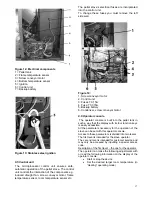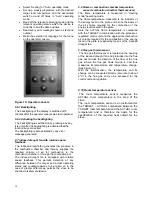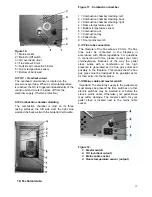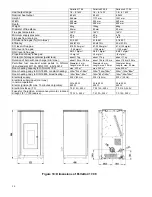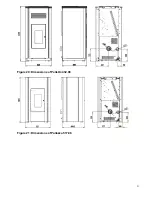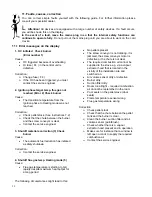
7
for the relationship of the “energy level in the grate” and
the combustion air volume taken in, which ensures “ideal
combustion” and a high level of efficiency.
During the “Heating mode” operating status, the rotation
speed of the induced draught fan is monitored by means
of rotation speed feedback and constant comparison
between the target and actual rotation speeds.
In the event of a large difference between the actual
rotation speed and the target rotation speed, a safety
shutdown will be initiated and an error message is
shown on the operator console display.
During the “Heating mode” operating status, the
maximum and minimum heat output are each controlled
by safety limits (maximum and minimum flue gas
temperature) i.e. if during the “Heating mode” operating
status the maximum flue gas temperature is exceeded
or if the flue gas temperature falls below the minimum, a
safety shutdown will be initiated.
5.3. Burner
test
Every 30 minutes during the “Heating mode” operating
status, a burner test is performed.
The burner test is performed regardless of the heat
output currently being delivered by the stove.
This process takes about 2 minutes.
5.4. Cooling
down
If the set target room temperature is reached i.e. the
actual room temperature and the target room
temperature match, then the control unit switches to
“Cooling down” operating status.
The fuel supply is stopped i.e. the screw conveyor that is
located in the screw conveyor tube, stops, the rotation
speed of the induced draught fan is regulated to a
precisely defined rotation speed and the fuel which is
still in the grate is burnt.
The cooling down phase is restricted by timing control
(duration about 15 minutes).
After the end of the “Cooling down” operating status, the
device switches to “Standby” operating status.
5.5. Standby
There is no combustion process going on in this
operating status, all the components, the induced
draught fan and the screw conveyor are stopped, the
ignition is switched off and the device is in a “waiting
position.”
Before the stove can switch back from “Standby”
operating status to the “Ignition phase” operating status,
two ignition conditions must be fulfilled:
1. The room temperature must be at least 1.0ºC
below the set target room temperature.
2. The flue gas temperature measured with the
thermosensor must be lower than 70°C.
It is only when both these ignition conditions have been
fulfilled that the device switches back from “Standby”
operating status to “Ignition phase” operating status.
L
Attention!
The device starts by itself in “Standby mode”.
Because of the heat generated on the panel, you
must ensure that there is no-one who is unfamiliar
with the operation of the pellet stove unsupervised
in the room where it is installed.
Placing non-heat-resistant materials or objects on
the stove or within the specified minimum distances
is forbidden.
5.6. Safety shutdown (shutdown)
If a fault occurs, regardless of in which operating status
or which operating mode, a safety shutdown is initiated.
The safety shutdown process is precisely defined.
During the safety shutdown, the components are
switched on or off as follows:
Induced draught fan – ON
Screw conveyor – OFF
Ignition – OFF
The ending of the safety shutdown is temperature-
dependent i.e. the “Safety shutdown” operating status is
maintained until the stove has cooled down to a flue gas
temperature of below 80°C.
Once the safety shutdown is ended, the control unit
switches to the “Fault” operating status.
5.7. Faults
The stove can no longer be automatically started up.
The operator can see the fault on the display.
Once the fault has been properly corrected and the error
message on the operator console has been cleared, the
stove may be started up again.

















